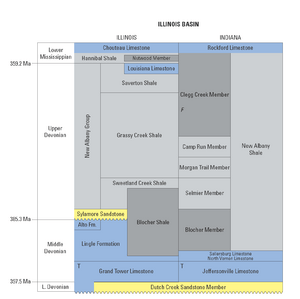Illinois Basin facts for kids
Quick facts for kids Illinois Basin |
|
|---|---|
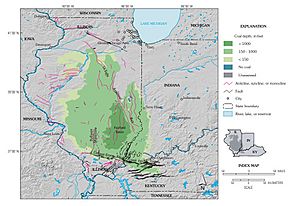
Basin structure map
|
|
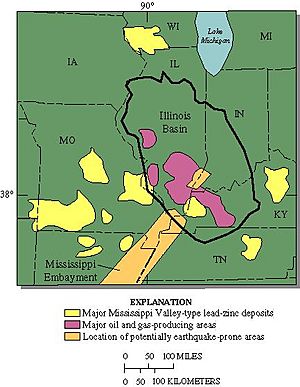
Location of the Illinois Basin (USGS)
|
|
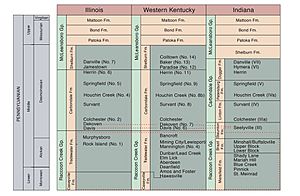
Pennsylvanian stratigraphy
|
|
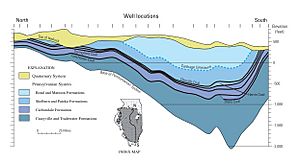
Illinois Basin cross-section
|
|
| Coordinates | 39°45′00″N 89°30′00″W / 39.7500°N 89.5000°W |
| Etymology | Illinois |
| Country | |
| State(s) | Illinois, SW Indiana, W Kentucky |
| Characteristics | |
| On/Offshore | Onshore |
| Boundaries | Kankakee Arch (NE), Cincinnati Arch (SE) Pascola Arch (S), Ozark Dome (SW) Mississippi River Arch (NW), Wisconsin Arch (N) |
| Area | 80,000 sq mi (210,000 km2) |
| Geology | |
| Plate | North American |
| Age | Cambrian-Pennsylvanian |
| Stratigraphy | Stratigraphy |
| Faults | New Madrid Seismic Zone, Wabash Valley Seismic Zone |
| Field(s) | Coal fields |
The Illinois Basin is a huge, bowl-shaped area of rock layers in the United States. It's mostly under the state of Illinois, but it also stretches into parts of southwestern Indiana and western Kentucky. This basin is very old, with rocks formed during the Paleozoic Era, millions of years ago. It's about 400 miles (640 km) long from northwest to southeast and 200 miles (320 km) wide from southwest to northeast.
Contents
What is the Illinois Basin?
Imagine a giant bowl made of rock layers. That's kind of what the Illinois Basin is! It's a place where sediments, like sand, mud, and shells, piled up over millions of years. These sediments then turned into different kinds of rock.
The basin is surrounded by natural underground bumps or ridges called "arches." These include the Kankakee Arch to the northeast and the Cincinnati Arch to the southeast. There are also areas where earthquakes can happen, like the New Madrid Seismic Zone, which touches the southern part of the basin.
Deep underground, at the center of the basin in southern Illinois, the rock layers are about 15,000 feet (4,570 meters) thick! These layers are mostly dolomite, limestone, shale, and sandstone. Even deeper, below all these sedimentary rocks, are much older "basement rocks" made of granite and rhyolite. These rocks are about 1.55 billion years old!
Important Resources from the Basin
The rocks in the Illinois Basin are a great source of valuable materials. These include coal, petroleum (oil), and other important minerals.
Coal
Bituminous coal is a type of coal found in the Pennsylvanian rocks of the basin. This coal formed from ancient plants that grew in freshwater swamps long ago. The Illinois Basin has produced a huge amount of coal over the years. More than eight billion tons have been dug up, especially in southern Illinois and western Kentucky. In 2008, the basin produced 99 million short tons of coal, which was about 8% of all coal produced in the U.S. that year.
Petroleum (Oil)
The Illinois Basin has also produced a lot of petroleum, or oil – over four billion barrels! Major oil production started in 1905. For a few years, from 1907 to 1912, it was the third most oil-rich area in the United States. Oil production reached its highest point in 1940, with 140 million barrels produced in just one year.
Recently, people have been looking for shale gas in the basin. This gas is trapped in a rock layer called the New Albany Shale, which formed during the Devonian and Mississippian periods.
Other Minerals
Besides coal and oil, the Illinois Basin also has other valuable minerals. These include lead, zinc, and fluorite. These minerals are found in places like Hardin and Pope counties in Illinois, and Crittenden and Livingston counties in Kentucky. They are often found in veins or as replacements in limestone rocks.
Storing Carbon Dioxide
Some of the rock layers in the Illinois Basin are being looked at as possible places to store carbon dioxide. This is a process called carbon sequestration. It means taking carbon dioxide, which is a gas that contributes to climate change, and putting it deep underground permanently.
In 2009, a company called Archer Daniels Midland started testing this idea. They began storing carbon dioxide deep beneath their ethanol factory in Illinois. By January 2015, they had successfully stored one million metric tons of carbon dioxide in the Illinois Basin-Decatur Project.




